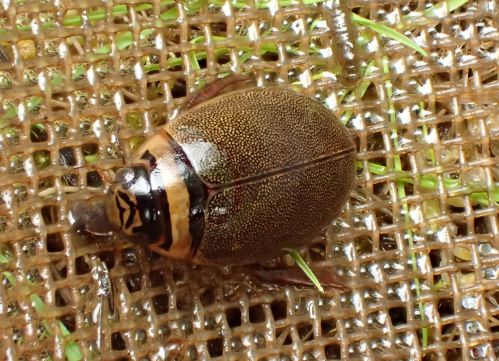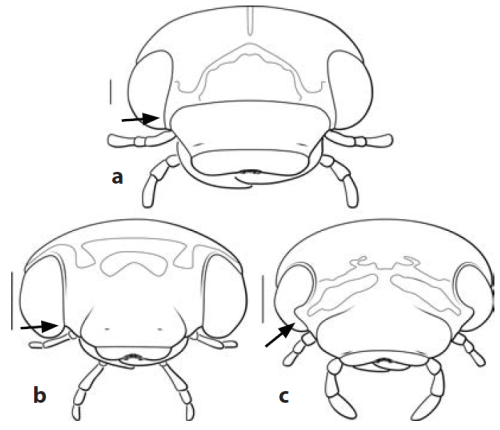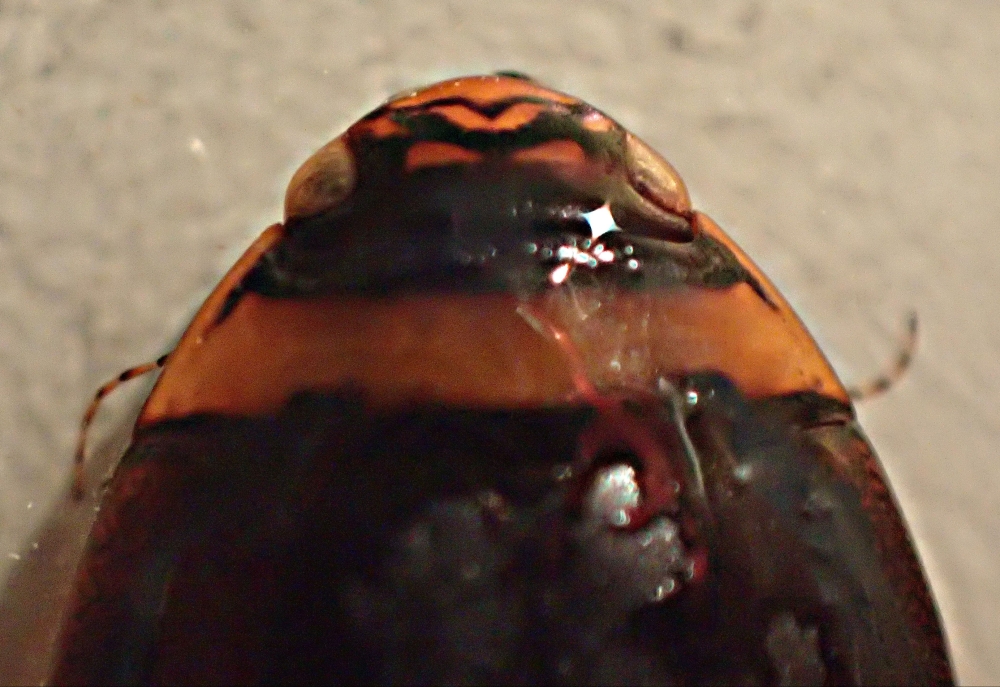My False Impression on Graphoderus
When in the field, I am capable of identifying some diving beetle species. The yellow band on the pronotum of a dytiscid, however, may confuse me at first glance: I can’t distinguish the genera Rhantus and Graphoderus when they are still diving in my traps. In my first impression, Graphoderus species (Figure 1) looked like a bigger version of Rhantus species. This, however, is totally a false impression!
- Read Rhantus in Finland

Indeed, Graphoderus species are on average larger than Rhantus species. In Finland, the body length of Graphoderus species is 11.2mm -15.8mm, while the body length of Rhantus species is 8.7mm – 12.2mm. Graphoderus, however, is definitely not a bigger version of Rhantus, as they belong to different subfamilies: Rhantus is under the subfamily Colymbetinae, while Graphoderus is under the same subfamily Dytiscinae as the genera Acilius and Dytiscus that I have written about before. Besides the body length, Graphoderus also look rounder than Rhantus.
Collecting Beetles during the Battle of Waterloo
If someone really wants to find some similarities between the two genera, I would tell the person that both genera were described by Pierre François Marie Auguste Dejean in 1833. Dejean was a French entomologist who served in the French army and rose to aide de campe to Napoleon. He owned the largest beetle collection at his time, with 22,399 species. Dejean was so enthusiastic that he even collected beetles during the Battle of Waterloo! Except that the two genera were described by the same entomologist, I haven’t found any other similarities between them yet.
Actually, if you are a beginner in dytiscid identification, there is a quick and scientific way to distinguish Graphoderus from Rhantus: Catch the beetle and look at the eyes. The answer is right there: The eyes of the subfamily Dytiscinae are anteriorly rounded (Figure 2.a&b), while the eyes of the subfamily Colymbetinae are anterolaterally emarginate (Figure 2.c).

Graphoderus in Finland
In Finland, there are only four Graphoderus species: G. austriacus, G. bilineatus, G. cinereus, and G. zonatus. Graphoderus austriacus was not recorded in Finland before 1960, while the conservation status of the other three species is all Least Concern in Finland. Interestingly, G. bilineatus (Figure 3) is an endangered species in the Global Red List due to its limited distribution and population. One needs to apply for special permission from ELY-keskus to collect this species. They all prefer habitats with dense vegetation, which gives you a clue where to find them. 🙂

Dispersal Capability and Species Conservation
Graphoderus species have limited dispersal capability very likely due to the oogenesis-flight syndrome. The oogenesis-flight syndrome refers to the phenomenon that dytiscids, also other insects, are capable of flight in the early stage of adult life and autolyse flight musculature after dispersal to utilise the energy for reproduction. Iversen et al. (2013, 2017) found that Graphoderus only disperse in summer but not the rest of a year and that the connectivity between suitable habitats and the stability of habitats are important to them to establish large range sizes. Iversen et al. (2013) urge that conservation action of G. bilineatus and species with similar biology should be taken at a landscape level.
Read in Finnish: Rantusukeltajien Isompi Versio?
Read in Chinese: 《大一号的姬龙虱?》
References
Bilton, D.T., 2014. Dispersal in Dytiscidae. In Ecology, Systematics, and the Natural History of Predaceous Diving Beetles (Coleoptera: Dytiscidae), pp. 387-407. Springer, Dordrecht.
IUCN Red List: Graphoderus bilineatus link
Iversen, L.L., Rannap, R., Thomsen, P.F., Kielgast, J. and Sand‐Jensen, K., 2013. How do low dispersal species establish large range sizes? The case of the water beetle Graphoderus bilineatus. Ecography, 36(7), pp.770-777. Available
Iversen, L.L., Rannap, R., Briggs, L. and Sand‐Jensen, K., 2017. Time‐restricted flight ability influences dispersal and colonization rates in a group of freshwater beetles. Ecology and evolution, 7(3), pp.824-830. Available
Miller, K.B. and Bergsten, J. (2016) Diving beetles of the world: Systematics and Biology of the Dytiscidae. JHU Press.
Rassi, P., Hyvärinen, E., Juslén, A. and Mannerkoski, I. (2010) The 2010 red list of Finnish species. Ympäristöministeriö & Suomen ympäristökeskus, Helsinki, p. 121. Available
Rassi, P., Karjalainen, S., Clayhills, T., Helve, E., Hyvärinen, E., Laurinharju, E., Malmberg, S., Mannerkoski, I., Martikainen, P., Mattila, J. and Muona, J. (2015) Kovakuoriaisten maakuntaluettelo 2015 [Provincial List of Finnish Coleoptera 2015]. Sahlbergia, 21(Suppl 1), p.13. Available

Pingback: 大一号的姬龙虱? – 文翡的博客
Pingback: Post List – Wenfei's Blog
Pingback: Rantusukeltajien Isompi Versio? – Wenfein Blogi
Nicely captured Graphoderus zonatus 🙂
LikeLike